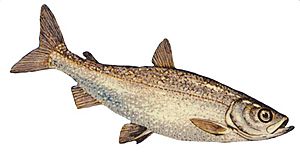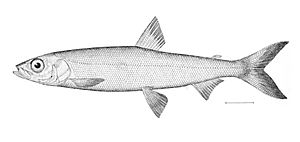Bloater facts for kids
Quick facts for kids Bloater |
|
|---|---|
 |
|
| Conservation status | |
| Scientific classification | |
| Synonyms | |
|
Argyrosomus hoyi Milner, 1874 |
The bloater (scientific name: Coregonus hoyi) is a type of freshwater whitefish that belongs to the Salmonidae family, which also includes salmon and trout. This fish looks a bit like a herring and has a shiny, silvery color. It usually grows to about 25.5 centimeters (10 inches) long. You can find bloaters in most of the Great Lakes and in Lake Nipigon. They like to live on underwater slopes in deep water. It's important not to confuse the bloater with the deepwater cisco, which is an extinct fish that used to share a similar common name.
Contents
What Does the Bloater Look Like?
The bloater is a small, silvery fish with pretty pink and purple shimmering colors. Its back often has a greenish tint, and its belly is whitish. It looks very similar to another fish called the kiyi. You can tell them apart because the bloater has a lighter upper lip and smaller eyes. Its body is widest in the middle, and it has small, pale fins. It also has 40 to 47 long gill rakers, which are like filters that help it catch food. The person who first discovered the bloater, P. R. Hoy, thought it was "the most beautiful of the white fish." Bloaters can grow up to 37 centimeters (14.6 inches) long, but they are usually around 25.5 centimeters (10 inches).
Where Do Bloaters Live?
Bloaters are originally from all the Great Lakes, except Lake Erie, and also from Lake Nipigon. Sadly, their numbers have been going down across these areas. Because of this, the IUCN Red List lists the bloater as a Vulnerable fish, meaning it's at risk of global extinction.
Bloaters disappeared from Lake Ontario and Lake Nipigon. They are not very common in Lake Michigan and their numbers are still dropping in Lake Superior and Lake Huron. The main reasons for this decline are other fish like the alewife eating them, and also sea lamprey attacks and pollution.
However, there's good news! People have been working hard to bring bloaters back to Lake Ontario, and these efforts have been very successful. Many fishery groups in North America have helped bloaters return to the lake. This is important because bloaters help keep the lake's food web healthy. Recent studies show that this fish has made an amazing comeback and is now living in Lake Ontario again. State, provincial, and federal groups aimed to put 500,000 bloaters into Lake Ontario by 2015.
How the Bloater Got Its Name
The scientific name for the bloater, Coregonus hoyi, was given after Dr. P. R. Hoy from Racine, Wisconsin. Dr. Hoy was the first person to collect samples of this fish in 1870. He found them while dredging in Lake Michigan, about 16 miles (26 kilometers) off Racine, in waters that were 90 to 130 meters (295 to 426 feet) deep.
Dr. Hoy didn't name the fish himself. Instead, he had a fish expert named James W. Milner give it a name. Milner first put it in a group called Argyrosomus, but now it's placed in the Coregonus group. The name Coregonus comes from Greek words and means "angled eye," which describes the tilted pupil of whitefishes.
The bloater is closely related to the cisco or lake herring (Coregonus artedi) and the shortjaw cisco. It's even known to hybridize with them, meaning they can have offspring together. The common name "bloater" comes from how the fish looks swollen after being brought up from the deep water where it lives. A similar name is used for a type of smoked herring in Britain that also looks swollen after being prepared. The bloater is part of a group of freshwater whitefishes called the Coregonus artedi complex. Sometimes, all the fish in this group are considered to be one single species.
Bloater's Life and Habits
Bloaters live in deep waters, usually between 30 and 198 meters (98 to 650 feet) deep. They prefer underwater slopes and can handle water temperatures between 1.5 and 11.4 degrees Celsius (34.7 to 52.4 degrees Fahrenheit). When a bloater is brought up to the surface quickly, its gas bladder expands, which makes it look swollen. This is how it got its common name!
Bloaters mostly eat small animals that live on the lake bottom, which are called zoobenthos. But sometimes, they will also eat tiny drifting animals, or zooplankton. Some of their favorite foods include a type of shrimp called Mysis diluviana and an animal called Diporeia hoyi, which is also named after P. R. Hoy.
Larger fish like the lake trout, different kinds of introduced salmon, and the burbot all like to eat bloaters. In the 1800s, bloaters were very common and often caught by fishermen, who sometimes called them "moon-eyes." People thought they were good to eat as a "panfish" (a fish small enough to fit in a frying pan), but they were too small to sell widely. Since most of the other "chubs" (a type of fish) in the Great Lakes have disappeared, bloaters have grown larger on average. Now, they are caught and smoked in the United States. Sport fishermen usually don't try to catch bloaters because they are small, live very deep, and have mouths that are too tiny for bait.
Bloaters can lay eggs all year round, but they usually do it in the winter or autumn. They lay their eggs in deep water, from 37 to 92 meters (121 to 302 feet) down. The number of eggs a female lays depends on her size, ranging from about 3,230 to 18,768 eggs. The eggs take about 4 months to hatch. When they hatch, baby bloaters are only about 1.01 centimeters (0.4 inches) long.
Young bloaters first go to the cool bottom of the lakes. Later, they start swimming in the open water (pelagic) before becoming bottom-dwellers by their first summer. Many young bloaters don't survive until they are big enough to avoid being eaten by other bloaters or alewives. Bloaters grow slowly because there isn't a lot of food in their deep-water homes. They usually become adults when they are about 18.3 centimeters (7.2 inches) long. The oldest bloater found lived for 10 years.
See also
 In Spanish: Coregonus hoyi para niños
In Spanish: Coregonus hoyi para niños



